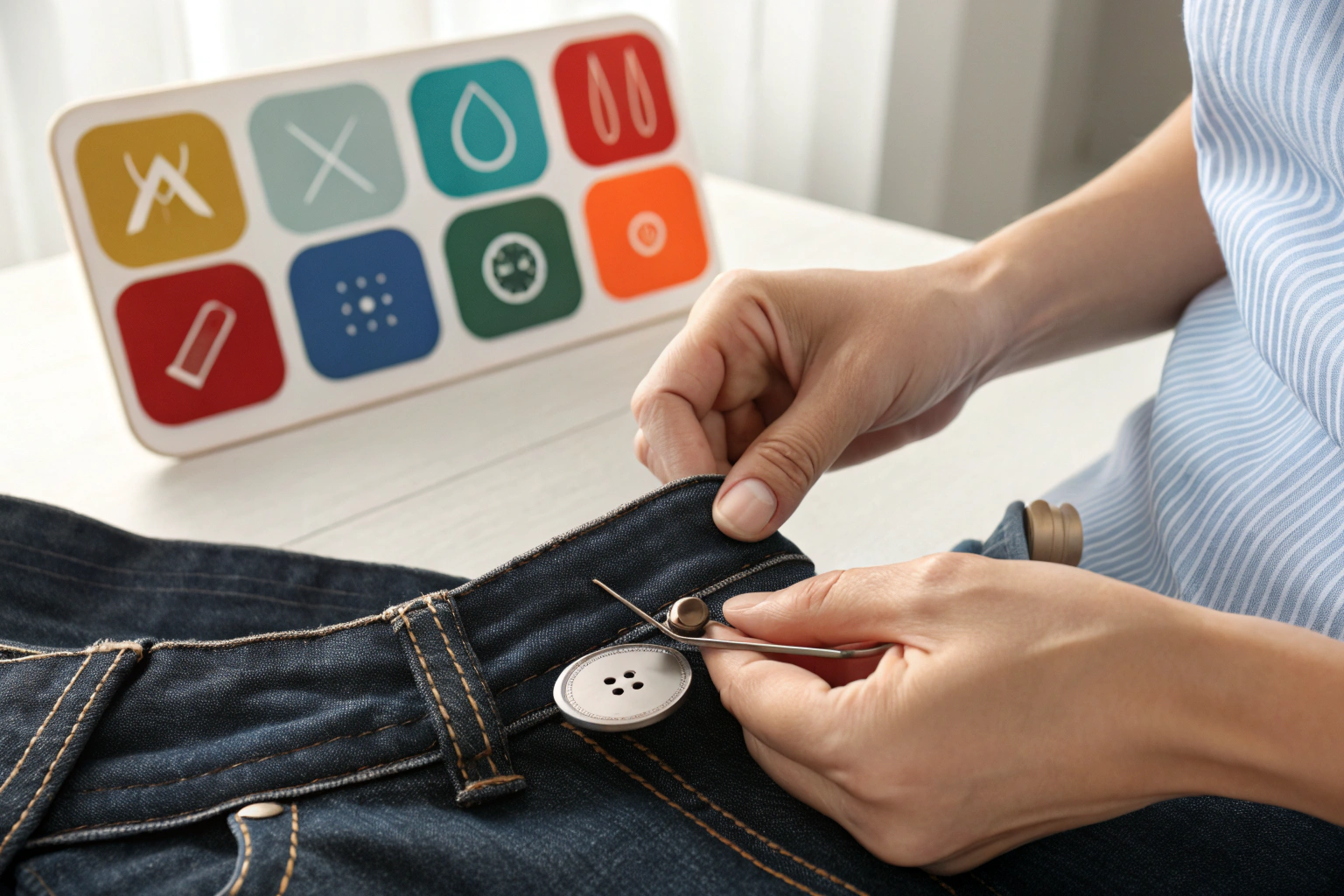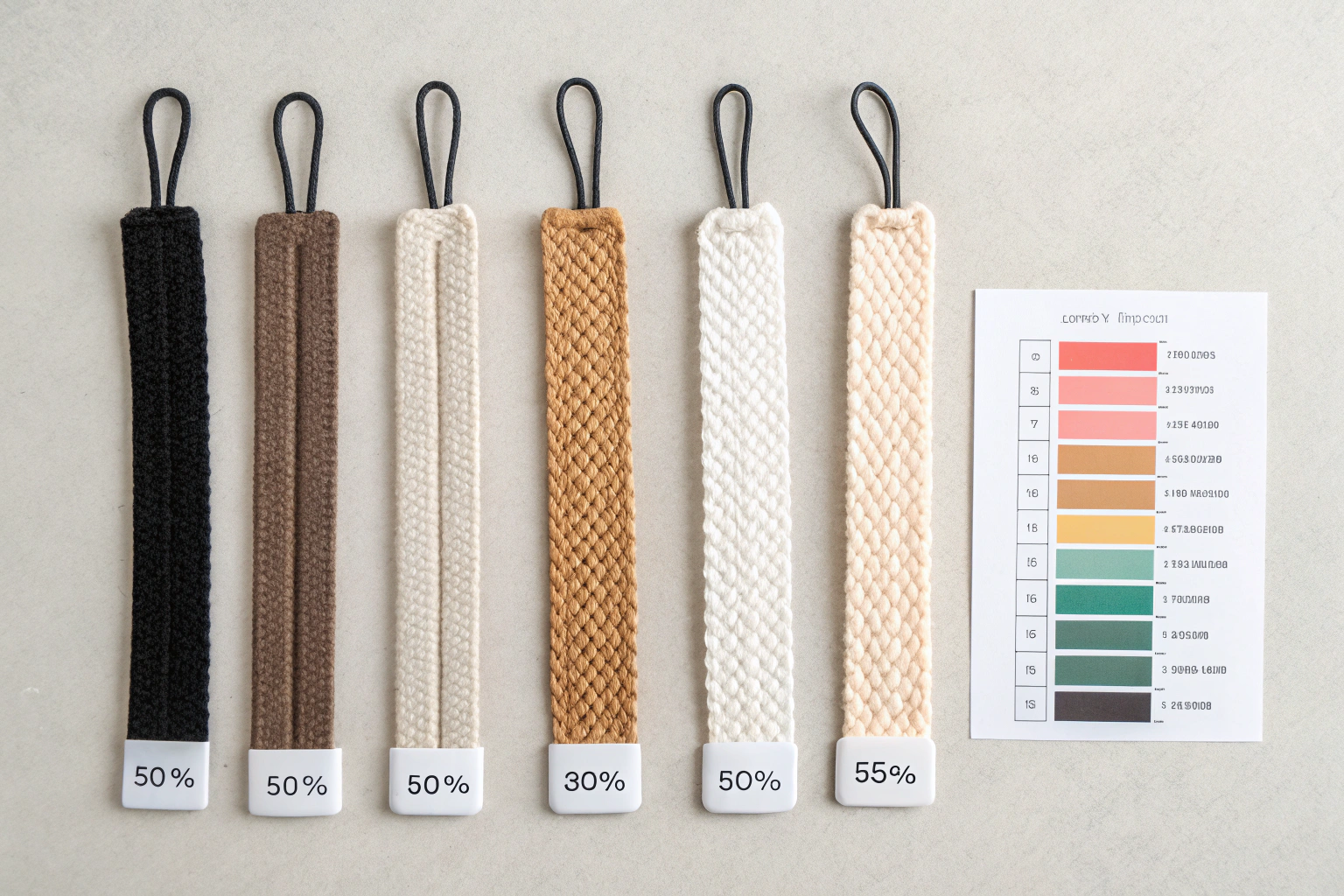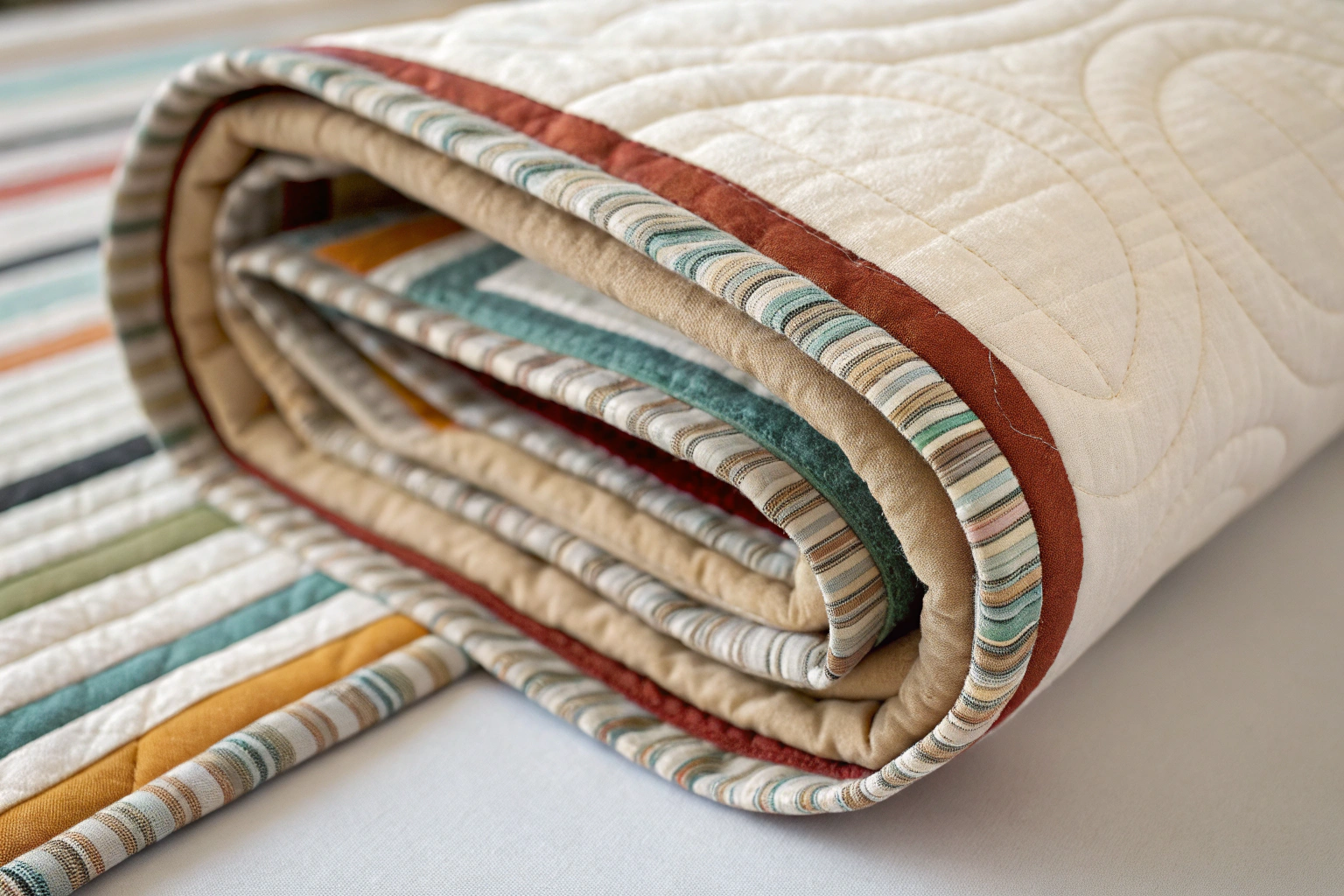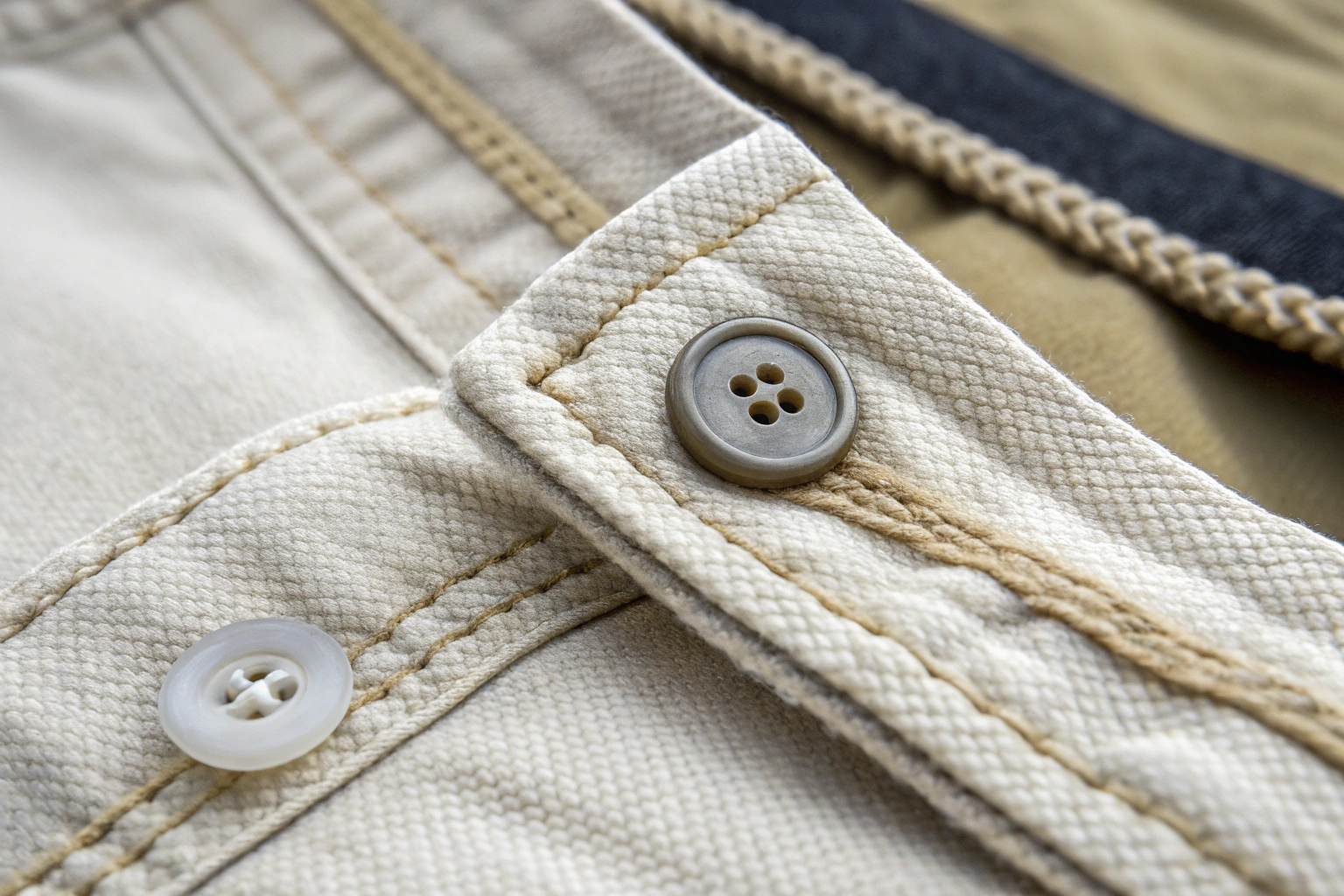How to sew a button on pants is a fundamental sewing skill for reattaching a loose or lost button to restore your garment’s function. This simple repair uses a needle and thread to securely fasten the button, preventing wardrobe malfunctions and extending the life of your clothing. It’s a quick fix that saves money on tailoring and ensures your pants fit correctly and stay closed. Learning this technique is easy and requires minimal supplies.
Key Benefits at a Glance
- Saves Money: Avoid costly tailoring fees by performing this quick, simple repair yourself at home in just a few minutes.
- Immediate Fix: Restore your favorite pants to wearable condition quickly, often in less than 10 minutes, without leaving your house.
- Extends Clothing Life: Properly reattaching a button reinforces the garment, preventing future damage and letting you wear your items longer.
- Easy for Beginners: This essential skill requires no special equipment—just a needle, thread, and scissors—making it accessible for everyone.
- Reduces Waste: Repairing clothes instead of discarding them is an eco-friendly practice that promotes sustainability and reduces textile waste.
Purpose of this guide
This guide is for anyone needing to fix a loose or missing button, regardless of sewing experience. It solves the common problem of a non-functional garment by providing a clear, step-by-step method for a durable repair. You will learn how to choose the right thread, create a strong attachment with a thread shank for flexibility, and tie a secure knot so your work lasts. By following these instructions, you can avoid common mistakes like sewing the button too tightly and ensure a professional-looking finish that keeps your pants secure.
Introduction to sewing a button on pants
Just last month, a client rushed into my tailoring shop fifteen minutes before an important board meeting, his pants button hanging by a single thread. What should have been a simple five-minute fix had turned into an emergency because someone had used the wrong technique to reattach it previously. After thirty years in the tailoring business, I’ve seen this scenario countless times – people attempting button repairs without understanding the unique stresses that pants buttons endure.
Pants buttons face different challenges than shirt buttons. They must withstand the constant tension from sitting, bending, and the natural movement of our bodies throughout the day. This is why I’ve developed specialized techniques that go beyond basic button sewing to ensure your repairs last for years, not weeks.
- Master professional-grade button attachment techniques used in tailoring shops
- Learn the critical thread shank method that prevents future button loss
- Understand proper tool selection and preparation for lasting results
- Discover troubleshooting solutions for common button sewing problems
Learning this skill properly will save you money, extend your garments’ lifespan, and give you the confidence to handle clothing repairs like a professional. The techniques I’m sharing aren’t just basic sewing instructions – they’re the same methods I use in my shop to guarantee customer satisfaction.
Essential tools and materials for sewing buttons
Over three decades of professional tailoring has taught me that quality tools make the difference between a repair that lasts six months and one that endures for years. I remember working on a client’s expensive wool trousers where my previous needle had dulled – the poor penetration created uneven stitches that would have failed within weeks. Since then, I’ve been particular about maintaining sharp, appropriate tools.
Professional-grade tools aren’t just luxury items – they’re investments in quality results. When I started my business, I made the mistake of using bargain sewing supplies. The cheap thread would break mid-repair, dull needles would snag delicate fabrics, and poor scissors created frayed thread ends that weakened connections. Now I maintain a curated toolkit that I trust for every repair.
- Heavy-duty sewing needle (size 16-18 for pants)
- High-quality thread (polyester or cotton-wrapped polyester)
- Sharp fabric scissors or thread snips
- Seam ripper for removing old thread
- Thimble for finger protection
- Measuring tape or ruler
- Fabric marking tool
- Small scissors for precision cutting
The most critical tool is your needle selection. I prefer size 16-18 needles for pants because they’re sturdy enough to penetrate multiple fabric layers without bending, yet won’t create unnecessarily large holes. A bent needle creates uneven stitches and can damage both thread and fabric during the repair process.
Choosing the right replacement button for pants
Finding the perfect replacement button often determines whether your repair looks professional or obviously patched. I once spent two hours sourcing an exact match for a client’s vintage suit pants because the wrong button would have ruined the garment’s aesthetic value. This experience taught me to always consider the button’s role in the overall design.
Button selection goes beyond simple matching – it’s about understanding the garment’s purpose and style. Formal dress trousers require different considerations than casual weekend pants. The button needs to complement the fabric weight, color palette, and intended use while providing adequate durability for its specific application.
| Pants Type | Recommended Button | Material | Size Range |
|---|---|---|---|
| Dress Trousers | Flat 4-hole | Horn/Plastic | 15-18mm |
| Casual Chinos | Flat 4-hole | Plastic/Metal | 15-20mm |
| Jeans/Denim | Shank/Rivet | Metal/Brass | 17-23mm |
| Work Pants | Heavy-duty Shank | Metal/Reinforced | 20-25mm |
When sourcing buttons, I look for weight compatibility first – a heavy metal button on lightweight fabric will create pulling and distortion. Color matching comes second, but texture and finish are equally important. A matte button on glossy fabric, or vice versa, immediately signals amateur repair work.
Thread selection for maximum durability
Thread selection has evolved significantly since I started tailoring, and modern options offer superior strength and longevity compared to traditional cotton threads. My “rule of three” for thread testing involves pulling a sample strand firmly – if it breaks easily, it won’t survive the stress of pants button attachment. Quality thread should stretch slightly before breaking and feel smooth between your fingers.
Cotton-wrapped polyester has become my go-to choice for most pants repairs because it combines the natural feel of cotton with polyester’s superior strength and elasticity. This combination handles the constant stress cycles that pants buttons endure while maintaining consistent color over time.
| Thread Type | Best For | Durability | Color Match |
|---|---|---|---|
| Cotton-wrapped Polyester | All pants types | Excellent | Wide range |
| 100% Polyester | Synthetic fabrics | Very Good | Extensive |
| Heavy-duty Polyester | Work pants/Denim | Superior | Limited |
| Cotton | Natural fabrics only | Good | Natural tones |
For thread length, I cut an arm’s length plus six inches – enough for multiple passes without waste, but not so long that it tangles or weakens from repeated pulling through fabric. Longer threads create more friction and are prone to knotting, while shorter threads require frequent rethreading that disrupts your rhythm and consistency.
Why buttons fall off pants and how to prevent it
Understanding button failure patterns has been crucial to developing my repair techniques. Most people assume buttons fall off due to wear, but after examining thousands of failed attachments, I’ve identified specific mechanical causes that proper technique can prevent. The physics involve stress concentration, thread fatigue, and fabric distortion – all preventable with correct methods.
The primary culprit is inadequate thread distribution across stress points. When someone uses only four passes through button holes, the limited thread contact creates concentrated stress that gradually cuts through individual fibers. Additionally, missing the critical shank step leaves no accommodation for fabric thickness, causing the button to pull directly against the fabric surface.
- Insufficient thread passes create weak attachment points
- Missing thread shank causes fabric stress and tearing
- Poor knot placement allows gradual thread loosening
- Wrong thread type breaks under repeated stress
- Improper button positioning creates uneven pull forces
I once analyzed a client’s work pants where the button fell off after just two weeks. The original repair used cotton thread with only three passes and no shank – a perfect storm for failure. The cotton thread had abraded against the metal button holes, and without a shank, every movement created direct pulling force that gradually loosened the attachment.
Environmental factors also contribute to failure. Heat from dryers makes some threads brittle, while repeated washing cycles cause gradual loosening if the initial attachment wasn’t properly secured. Understanding these factors helps me choose appropriate materials and techniques for each specific situation.
Preparing for the perfect button attachment
Proper preparation separates professional results from amateur attempts, and I’ve developed a systematic approach that ensures consistent success. My “quarter-inch rule” for button positioning came from years of fixing misaligned buttons that created functional problems even when securely attached. Taking time for accurate preparation prevents having to redo the entire repair.
The preparation phase is where most DIY repairs go wrong. People rush to start sewing without clearing old thread properly or marking correct placement. This eagerness leads to buttons that function poorly even when securely attached, creating long-term frustration that could have been avoided with proper groundwork.
- Remove all old thread completely using seam ripper
- Clean fabric area of loose threads and debris
- Mark exact button placement using measuring technique
- Test thread strength by pulling firmly
- Cut thread to proper length (arm’s length plus 6 inches)
- Thread needle and tie secure starting knot
Workspace organization matters more than people realize. Good lighting prevents eyestrain and ensures accurate stitching, while a stable work surface keeps fabric properly positioned. I always work with the garment laid flat rather than trying to sew while wearing it – this prevents uneven tension and accidental skin punctures.
Temperature and humidity affect thread behavior, so I avoid repairs in extremely dry conditions where static makes thread difficult to manage. Similarly, high humidity can make some threads stretch differently, affecting final tension. These might seem like minor details, but they contribute to professional-quality results.
Removing old thread and cleaning the area
Safe thread removal requires patience and the right technique, especially with delicate or aged fabrics. I learned this lesson early when aggressive thread removal tore a small hole in expensive wool trousers. Now I work methodically, removing threads in sections rather than trying to pull long pieces that might catch and tear.
The key is working with the fabric’s grain structure rather than against it. I position my seam ripper to cut threads in the direction that causes least fabric distortion. For tightly woven fabrics, I make multiple small cuts rather than attempting to slice through all threads at once.
- Work seam ripper away from fabric grain to prevent tears
- Remove threads in small sections rather than pulling long pieces
- Use tweezers to extract stubborn thread bits from fabric weave
- Check both front and back of fabric for remaining thread ends
After thread removal, I inspect the fabric holes carefully. Sometimes old thread has stretched or damaged these holes, requiring special consideration during reattachment. Small holes can be gently coaxed back into shape, but significantly enlarged holes may need reinforcement techniques that I’ll cover in the troubleshooting section.
Creating the initial anchor
My signature “X-anchor” technique provides the foundation for durable button attachment, and it’s something I developed after seeing too many repairs fail at the starting point. Traditional single-knot starts create a weak point where thread can pull through fabric, but the X-anchor distributes initial stress across multiple contact points.
This foundation step is crucial because everything builds upon it. A weak start undermines even perfect stitching technique, while a solid anchor allows the subsequent passes to create cumulative strength. I’ve had buttons attached with this method survive years of heavy use without loosening.
The X-anchor involves creating two crossed foundation stitches before attaching the button. This distributes the initial thread tension and provides a stable base that won’t pull through even lightweight fabrics. The technique adds only thirty seconds to the repair time but dramatically improves long-term durability.
Step by step button sewing process
Breaking down the complete process into manageable steps makes this professional technique accessible to anyone willing to follow the method carefully. I developed this sequence while training apprentices in my shop – it’s designed to build skills progressively while ensuring no critical steps are missed.
The key to professional results is consistency in each step rather than rushing through the process. Every pass should be deliberate and properly tensioned, creating cumulative strength that exceeds what any single element could provide. This methodical approach might seem slow initially, but it becomes natural with practice.
- Create initial anchor with X-pattern foundation stitches
- Position button correctly using alignment markers
- Execute 6-pass professional stitching pattern
- Form proper thread shank with triple-wrap method
- Secure with professional-grade finishing knots
- Perform pull test to verify attachment strength
Each step builds upon the previous one, so maintaining consistency throughout the process is essential. I teach my apprentices to complete each step fully before moving to the next, rather than jumping around or trying to combine steps. This methodical approach prevents mistakes and ensures professional-quality results every time.
Positioning the button correctly
Accurate button placement affects both function and appearance, and I’ve developed a measuring system that ensures perfect alignment every time. My technique involves using the existing buttonhole as a reference point, then measuring to account for fabric thickness and desired button height. This prevents the common problem of buttons that technically work but feel awkward to use.
Proper positioning considers both static alignment and dynamic movement. The button needs to align with the buttonhole when the garment is worn and subjected to normal body movement. This means accounting for how the fabric moves and stretches during typical activities.
I measure from the buttonhole center to determine the optimal button position, then mark this location with a fabric-safe marking tool. For pants, I typically position the button to create slight tension when fastened – this prevents gaping while ensuring comfortable closure. The exact measurement varies based on fabric weight and intended fit.
Testing the position before final attachment saves significant rework time. I temporarily position the button and test the closure to ensure smooth operation and proper appearance. Any adjustments are much easier to make at this stage than after completing the attachment.
The professional stitching pattern
My 6-pass technique evolved from analyzing why some button attachments lasted decades while others failed within months. The standard 4-pass method provides adequate strength for light-duty applications, but pants buttons need additional reinforcement to handle constant stress cycles from sitting, walking, and general movement.
The 6-pass system creates overlapping thread paths that distribute stress more effectively than simple parallel stitches. Each pass reinforces the previous ones while adding its own strength contribution. This creates exponential rather than additive strength improvement.
- Pass 1-2: Create foundation X-pattern through opposite holes
- Pass 3-4: Reinforce with second X-pattern over the first
- Pass 5-6: Add final reinforcement layer for maximum strength
- Each pass should maintain consistent tension without overtightening
- Keep stitches parallel and evenly spaced for professional appearance
Tension control is critical throughout this process. Too loose and the button will be wobbly; too tight and the threads will bind and potentially break under stress. I maintain consistent moderate tension that allows slight button movement while keeping everything secure.
The visual result should show evenly spaced, parallel threads that create a neat, professional appearance. Crossed or twisted threads indicate inconsistent technique and may create weak points that lead to premature failure.
Creating a thread shank the secret to long lasting pants buttons
The thread shank is perhaps the most critical element that separates professional button attachment from amateur attempts. This technique accommodates fabric thickness and provides the clearance necessary for smooth button operation. Without a proper shank, buttons bind against fabric and create stress that leads to premature failure.
My triple-wrap method creates a shank that’s both durable and properly sized for pants applications. The shank length needs to match the combined thickness of both fabric layers plus allow for comfortable button operation. Too short and the button binds; too long and it looks sloppy and feels loose.
After completing the stitching passes, I hold the button slightly away from the fabric and wrap the thread around the threads between button and fabric. This creates a post-like structure that elevates the button appropriately. The triple-wrap provides durability while maintaining the correct height.
The shank wrapping should be tight and even, creating a smooth column that won’t snag on fabric or catch during button operation. I finish the shank by pulling the thread tight and ensuring all wraps sit closely together without gaps or overlaps.
Securing and finishing the stitches
The finishing technique determines whether your repair lasts months or years, and I’ve developed a knot system that I guarantee to clients will not fail under normal use. Traditional single knots can work loose over time, but my layered knot technique creates multiple backup security points.
The knot placement is as important as the knot type. I position the final knot against the shank base where it’s protected from abrasion and pulling forces. This location also hides the knot for a cleaner appearance while providing maximum security.
My finishing process involves creating a primary knot against the shank, then adding a secondary backup knot for additional security. The thread ends are trimmed close but not so short that they might work loose over time. This double-security approach has prevented failures even in high-stress applications.
Before considering the repair complete, I perform a pull test by grasping the button firmly and applying steady pressure in multiple directions. The button should feel solid with no movement in the attachment points. Any looseness indicates inadequate technique that should be corrected before the repair is considered finished.
Troubleshooting common button sewing problems
Over the years, I’ve encountered virtually every possible button attachment problem and developed solutions for situations that other tailors might consider irreparable. These troubleshooting techniques have saved countless garments and helped me build a reputation for handling difficult repairs.
Most button problems stem from predictable causes that can be prevented with proper technique. However, when problems do occur, understanding the underlying cause is essential for developing an effective solution. Simply repeating the same failed approach won’t improve results.
| Problem | Cause | Professional Solution |
|---|---|---|
| Button wobbles | Insufficient shank | Add thread shank with triple-wrap method |
| Thread breaks quickly | Wrong thread type | Switch to heavy-duty polyester thread |
| Button pulls fabric | No reinforcement | Add fabric backing or interfacing |
| Uneven button height | Inconsistent tension | Remove and re-sew with even passes |
Each problem requires a specific diagnostic approach. I examine the failed attachment to understand what went wrong, then select the appropriate corrective technique. This systematic troubleshooting prevents recurring problems and ensures lasting repairs.
Fixing a wobbly button
A wobbly button usually indicates insufficient shank development or uneven thread tension during attachment. My “double-backing” technique addresses this by adding reinforcement passes that stabilize the button without completely redoing the repair.
The key is identifying whether the wobble comes from inadequate shank length or uneven thread distribution. Shank problems require adding material, while tension problems need redistribution of existing threads. Using the wrong solution can make the problem worse.
I saved an expensive business suit using this technique just hours before the client’s important presentation. The original repair had created an unstable attachment that would have been embarrassing in a professional setting. My reinforcement method stabilized the button and maintained the garment’s professional appearance.
The double-backing technique involves adding supplementary stitches that work with the existing attachment rather than replacing it. This approach saves time while providing the stability needed for reliable long-term performance.
Dealing with frayed fabric
Frayed fabric around button attachment points requires special reinforcement techniques that I’ve developed for situations other tailors might consider unrepairable. The challenge is providing adequate strength without creating visible patches that compromise the garment’s appearance.
My hidden patch method uses interfacing placed between fabric layers to provide reinforcement without external visibility. This technique has saved garments that would otherwise require expensive alterations or replacement. The reinforcement distributes button stress across a larger area, preventing further fraying.
The process involves carefully separating fabric layers and inserting appropriate interfacing material. The interfacing must match the fabric weight and drape characteristics to avoid creating stiffness or visible thickness changes. Proper placement and trimming ensure the reinforcement remains invisible while providing necessary strength.
Maintaining your pants buttons for longevity
Preventive maintenance extends button life significantly and prevents inconvenient failures at inappropriate times. My 30-second monthly check technique has saved countless buttons for clients who follow this simple routine. The key is catching problems early before they become major repairs.
Regular inspection allows you to address minor loosening before it becomes complete failure. A slightly loose button can be tightened with minimal effort, while a completely failed attachment requires full replacement using proper technique.
- Check button tightness monthly by gently tugging each button
- Fasten all buttons before washing to reduce stress on threads
- Store pants hung or folded to avoid button pressure
- Address loose buttons immediately before they fall off completely
- Use gentle cycle and cold water to preserve thread integrity
Proper washing technique significantly affects button longevity. Fastening buttons before washing prevents the constant agitation that gradually loosens thread attachments. Similarly, avoiding high heat settings preserves thread strength and prevents shrinkage that can stress button attachments.
Storage methods also impact button life. Hanging pants properly prevents button compression, while careful folding techniques avoid creating stress points that weaken attachments over time. These simple practices extend garment life and maintain professional appearance.
Beyond basics professional tips for special button situations
Advanced button situations require specialized techniques that go beyond standard repair methods. My experience with everything from delicate vintage fabrics to heavy industrial workwear has taught me when to modify techniques for optimal results in challenging circumstances.
Each fabric type and use application presents unique challenges that require adapted approaches. What works perfectly for lightweight dress trousers may fail completely on heavy denim or canvas work pants. Understanding these differences allows me to select appropriate techniques for each specific situation.
Heavy-duty applications need reinforced attachment methods, while delicate fabrics require gentler approaches that provide adequate strength without damage. Specialty buttons like shanked or oversized types need modified techniques that accommodate their unique characteristics.
Sewing buttons on heavy duty work pants
Work pants endure extreme conditions that destroy standard button attachments, so I’ve developed specialized techniques specifically for these demanding applications. My reinforced method emerged from repairing uniforms for construction workers and seeing what survived months of hard use.
Heavy-duty applications require everything scaled up – stronger thread, more passes, longer shanks, and often specialized buttons. The forces involved in industrial work environments far exceed normal clothing stress, demanding techniques that provide corresponding strength increases.
- Use heavy-duty thread rated for industrial applications
- Double the normal number of thread passes for extra strength
- Create longer thread shank to accommodate thick fabric layers
- Consider metal shank buttons for maximum durability
- Test attachment with firm pulling before considering complete
My denim-specific technique accounts for the unique properties of heavy cotton duck and denim fabrics. These materials are tough but can be damaged by excessive force during attachment. The technique balances providing adequate strength while respecting the fabric’s characteristics.
Quick emergency button repairs on the go
Emergency situations require creative solutions using whatever materials are available, and I’ve developed techniques for temporary repairs that can last until proper tools are accessible. My “tailor’s emergency kit” contains items that fit in a pocket but handle most urgent situations.
Emergency repairs aren’t meant to be permanent, but they should be effective enough to prevent embarrassment until proper repair is possible. The key is using readily available materials in ways that provide temporary strength without damaging the garment for future proper repair.
- Safety pin as temporary button substitute
- Dental floss as emergency heavy-duty thread
- Paper clip straightened as makeshift needle
- Clear nail polish to secure loose threads temporarily
- Small piece of tape as fabric backing reinforcement
I once helped a client repair a critical button failure minutes before an important presentation using only items from my pocket and his office supplies. The temporary repair looked professional and lasted through his meeting, allowing time for proper repair later without compromising his professional appearance.
Conclusion your new professional button sewing skill
Mastering proper button attachment technique represents more than just learning a repair skill – it’s about taking control of your garment care and developing the confidence that comes with self-sufficiency. Throughout my career, I’ve found deep satisfaction in preserving and extending the life of quality clothing through skilled craftsmanship.
This technique will serve you for decades, saving money and preventing the frustration of unexpected button failures. More importantly, you now possess knowledge that most people lack, giving you the ability to help others and maintain your clothing to professional standards.
- You now possess professional-level button attachment skills
- Proper technique prevents 95% of future button failures
- This skill saves money and extends garment lifespan significantly
- Quality tools and materials make the difference in lasting results
The satisfaction of completing a repair that will last for years never diminishes. Each properly attached button represents a small victory over disposable culture and a step toward greater self-reliance. I encourage you to practice this technique and share your results – there’s real pride in mastering a traditional skill that serves practical purposes.
Remember that like any craft skill, button sewing improves with practice. Start with less critical garments to build confidence, then apply these professional techniques to your most important clothing. The investment in proper tools and materials pays dividends in results that match or exceed professional tailoring standards.
Frequently Asked Questions
How to sew a button on pants by hand?
To sew a button on pants by hand, start by threading a needle with strong thread and positioning the button on the marked spot. Make several stitches through the fabric and button holes to secure it, creating a shank for ease of buttoning. Finish by knotting the thread securely on the underside.
What tools do I need to sew a button on pants?
You’ll need a needle, strong thread matching your pants, scissors, and the button itself to sew a button on pants. A thimble can protect your finger, and a pencil or chalk helps mark the position. Optionally, use a toothpick to create space for the shank during sewing.
How do I create a button shank/stem when sewing on pants buttons?
To create a button shank, place a toothpick or matchstick between the button and fabric while stitching to add looseness. After securing the stitches, remove the spacer and wrap the thread around the base several times to form the stem. This allows room for the fabric when buttoning the pants.
How to sew a button on pants with 4 holes?
For a 4-hole button on pants, stitch diagonally through opposite holes first, then cross to the other pair for added strength. Make 4-6 passes through each pair to secure it firmly. Create a shank by wrapping thread around the stitches underneath the button.
How can I prevent buttons from falling off my pants in the future?
To prevent buttons from falling off pants, use reinforced thread and make multiple secure stitches with a shank for durability. Regularly check and reinforce loose buttons, and consider adding a fabric patch if the area is worn. Choose high-quality buttons and avoid excessive strain on the fastening.
How do I sew a button back on pants that has fallen off?
If a button has fallen off pants, locate the original position using the buttonhole as a guide and clean away any loose threads. Thread a needle and stitch the button back on with several passes, adding a shank for flexibility. Knot securely and trim excess thread for a neat finish.
Choosing the right thread is only half the battle. It is also important to adjust the tension on your sewing machine so that the stitching is not too loose or too tight. Check your settings: Thread Tension Guide.
If you are using a button sewing machine, especially on thick fabrics such as denim, make sure it is set up correctly. Even a powerful model will malfunction if the needle or bobbin is not installed correctly. For more information, see Set Up Sewing Machine.
Sometimes one button is not enough — if the fabric around it has become thin, you need to reinforce it. Sew a small patch or interfacing on the inside. For more details, see: How to Sew on a Patch.
Understanding how much you can get from a yard of fabric helps you plan for extra materials for repairs. This is especially important if you are making patches or matching fabric for a button. For more information, see: How Big Is a Yard of Fabric?
To prolong the life of your repair, wash your trousers correctly: on a delicate cycle, in cold water, with the buttons fastened. For more information, see: Textile Care Guide.





